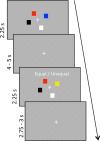Working memory performance in the elderly relates to theta-alpha oscillations and is predicted by parahippocampal and striatal integrity
- PMID: 30679512
- PMCID: PMC6345832
- DOI: 10.1038/s41598-018-36793-3
Working memory performance in the elderly relates to theta-alpha oscillations and is predicted by parahippocampal and striatal integrity
Abstract
The ability to maintain information for a short period of time (i.e. working memory, WM) tends to decrease across the life span with large inter-individual variability; the underlying neuronal bases, however, remain unclear. To address this issue, we used a multimodal imaging approach (voxel-based morphometry, diffusion-tensor imaging, electroencephalography) to test the contribution of brain structures and neural oscillations in an elderly population. Thirty-one healthy elderly participants performed a change-detection task with different load conditions. As expected, accuracy decreased with increasing WM load, reflected by power modulations in the theta-alpha band (5-12 Hz). Importantly, these power changes were directly related to the tract strength between parahippocampus and parietal cortex. Furthermore, between-subject variance in gray matter volume of the parahippocampus and dorsal striatum predicted WM accuracy. Together, our findings provide new evidence that WM performance critically depends on parahippocampal and striatal integrity, while theta-alpha oscillations may provide a mechanism to bind the nodes within the WM network.
Conflict of interest statement
The authors declare no competing interests.
Figures






Similar articles
-
Cross-frequency interactions between frontal theta and posterior alpha control mechanisms foster working memory.Neuroimage. 2018 Nov 1;181:728-733. doi: 10.1016/j.neuroimage.2018.07.067. Epub 2018 Jul 31. Neuroimage. 2018. PMID: 30075276
-
Brain oscillatory correlates of working memory constraints.Brain Res. 2011 Feb 23;1375:93-102. doi: 10.1016/j.brainres.2010.12.048. Epub 2010 Dec 21. Brain Res. 2011. PMID: 21172316 Review.
-
Alpha Oscillations Are Causally Linked to Inhibitory Abilities in Ageing.J Neurosci. 2018 May 2;38(18):4418-4429. doi: 10.1523/JNEUROSCI.1285-17.2018. Epub 2018 Apr 3. J Neurosci. 2018. PMID: 29615485 Free PMC article.
-
Acetylcholine modulates human working memory and subsequent familiarity based recognition via alpha oscillations.Neuroimage. 2016 Aug 15;137:61-69. doi: 10.1016/j.neuroimage.2016.05.049. Epub 2016 May 21. Neuroimage. 2016. PMID: 27222217
-
Working memory and neural oscillations: α-γ versus θ-γ codes for distinct WM information?Trends Cogn Sci. 2014 Jan;18(1):16-25. doi: 10.1016/j.tics.2013.10.010. Epub 2013 Nov 19. Trends Cogn Sci. 2014. PMID: 24268290 Review.
Cited by
-
Age-related slowing down in the motor initiation in elderly adults.PLoS One. 2020 Sep 16;15(9):e0233942. doi: 10.1371/journal.pone.0233942. eCollection 2020. PLoS One. 2020. PMID: 32937652 Free PMC article.
-
Age-Related Changes in Functional Connectivity during the Sensorimotor Integration Detected by Artificial Neural Network.Sensors (Basel). 2022 Mar 25;22(7):2537. doi: 10.3390/s22072537. Sensors (Basel). 2022. PMID: 35408153 Free PMC article.
-
Single-value scores of memory-related brain activity reflect dissociable neuropsychological and anatomical signatures of neurocognitive aging.Hum Brain Mapp. 2023 Jun 1;44(8):3283-3301. doi: 10.1002/hbm.26281. Epub 2023 Mar 27. Hum Brain Mapp. 2023. PMID: 36972323 Free PMC article.
-
Distinct neural activations correlate with maximization of reward magnitude versus frequency.Cereb Cortex. 2023 May 9;33(10):6038-6050. doi: 10.1093/cercor/bhac482. Cereb Cortex. 2023. PMID: 36573422 Free PMC article.
-
Semantic Congruence Drives Long-Term Memory and Similarly Affects Neural Retrieval Dynamics in Young and Older Adults.Front Aging Neurosci. 2021 Sep 14;13:683908. doi: 10.3389/fnagi.2021.683908. eCollection 2021. Front Aging Neurosci. 2021. PMID: 34594212 Free PMC article.
References
Publication types
MeSH terms
LinkOut - more resources
Full Text Sources
Molecular Biology Databases
Research Materials

